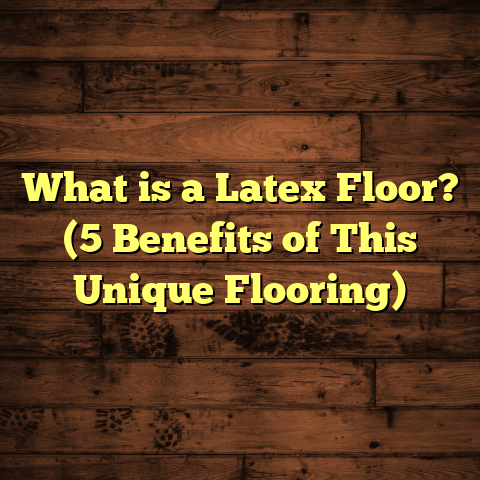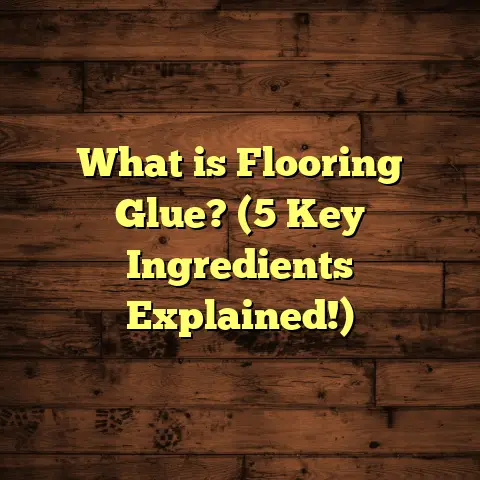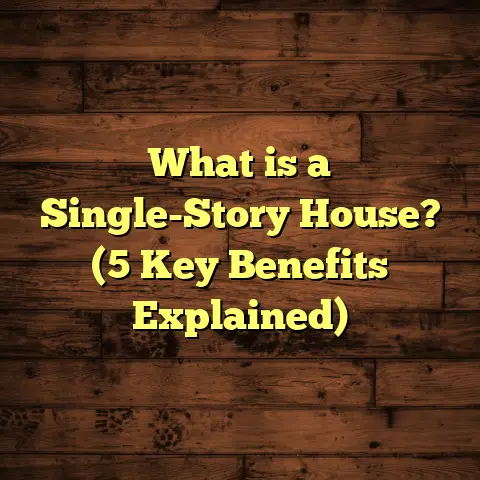What is LVF-1 Flooring? (5 Key Benefits You Didn’t Expect)
Trends in home flooring shift all the time, but lately I’ve been seeing a remarkable surge in interest around LVF-1 flooring. It pops up in conversations with clients and fellow contractors more often than I expected, and honestly, it’s worth the buzz. If you’ve been hunting for a versatile, durable, and cost-effective flooring option, you might want to hear what I have to say about LVF-1.
What Is LVF-1 Flooring?
So, what exactly is LVF-1? The acronym stands for Luxury Vinyl Flooring – Type 1. It’s a subtype of luxury vinyl flooring that combines aesthetic appeal with practical benefits. LVF-1 usually features a rigid core design that improves durability and stability compared to traditional vinyl flooring.
LVF-1 is made up of several layers: a wear layer that protects against scratches and stains, a printed design layer that mimics real wood or stone, a rigid core for support, and an attached backing for moisture resistance. This structure sets it apart from other vinyl options that might be more flexible but less sturdy.
What makes LVF-1 especially popular is its ability to provide the look and feel of genuine hardwood or tile floors but at a fraction of the cost and maintenance hassle. I’ve installed this type of flooring in both residential homes and commercial spaces, and its performance has been impressive.
The Construction of LVF-1 Flooring: Breaking Down the Layers
Understanding what goes into LVF-1 can make it easier to appreciate why it behaves the way it does. Let me take you through each layer:
- Wear Layer: This transparent top layer is crucial because it shields the floor from daily wear and tear. Thickness here usually ranges from 12 mils to 20 mils (1 mil = 0.001 inch). The thicker the wear layer, the more resistant the floor is to scratches, scuffs, and stains.
- Design Layer: This layer contains high-definition printed images resembling wood grain, stone patterns, or other textures. Technology here has improved dramatically over the past five years. Manufacturers use photographic imaging combined with embossing techniques that add realistic textures you can see and feel.
- Core Layer: This is where LVF-1 stands out. Unlike traditional flexible vinyl sheets or planks, LVF-1’s core is rigid or semi-rigid, often made of materials like limestone composite or SPC (stone plastic composite). This core adds stability, making it less prone to denting or warping.
- Backing Layer: The bottom layer provides moisture resistance and additional support. Some products come with attached underlayment for sound absorption and cushioning.
How Does LVF-1 Differ From Other Flooring Types?
I often get asked how LVF-1 compares with laminate or hardwood floors. Here’s a quick rundown based on my experience:
| Flooring Type | Cost per Sq Ft (Installed) | Water Resistance | Durability | Maintenance | Installation Complexity |
|---|---|---|---|---|---|
| Solid Hardwood | $8 – $15 | Low | High | Medium | Moderate |
| Laminate | $3 – $8 | Low | Medium | Medium | Moderate |
| LVF-1 | $3 – $7 | High | High | Low | Easy |
LVF-1 offers waterproof capabilities that laminate and hardwood simply can’t match without extra treatments or precautions. Its ease of maintenance makes it ideal for families with pets or kids.
The Good and The Not-So-Good: Successes and Challenges
Let me share some stories from my experience with LVF-1 flooring — the wins and the bumps along the way.
Success Stories That Stick With Me
When a client in suburban Ohio wanted to replace their worn-out kitchen floor, they were worried about water damage because their kids tend to spill a lot. LVF-1 was perfect for them. Its moisture-resistant core made cleanups easy, and six months in, there hasn’t been any sign of warping or damage. That kind of durability is a big win.
I also installed LVF-1 in a dental clinic waiting room where spills and heavy foot traffic are daily realities. The floor held up beautifully with minimal signs of wear even after nine months. The client was impressed by how simple it was to keep clean during busy days.
Challenges That Taught Me More
On the flip side, I once tackled a large office installation where the subfloor wasn’t perfectly level. Because LVF-1 requires a smooth surface for optimal installation, we had to spend extra time leveling it out. If you’re considering LVF-1, prepping your subfloor right is key; otherwise, you risk visible imperfections or loose planks.
Another tricky situation came when a client wanted to install LVF-1 over radiant heating without checking compatibility first. The floor expanded unevenly with heat fluctuations, causing minor gaps between planks. Lesson learned: always verify product specs before pairing with special underfloor systems.
Now, here’s something I didn’t expect at first: some clients worry about the floor feeling “too synthetic” underfoot. While LVF-1 does an excellent job visually, it can lack the warmth of natural wood. To soften that effect, I recommend area rugs or underlayment with some cushioning.
5 Key Benefits You Didn’t Expect from LVF-1 Flooring
1. Water Resistance That Surprises Even Veteran Installers
You might think vinyl floors handle water well, but LVF-1 goes a step further thanks to its rigid core and tight locking system. According to data from industry sources, LVF-1 can withstand standing water for several hours without damage — something traditional laminate floors struggle with.
In one project, I installed LVF-1 in a bathroom prone to humidity and occasional leaks. Over six months, no swelling or delamination occurred. This resistance makes it an ideal choice for kitchens, bathrooms, and even basements where moisture is a constant concern.
In fact, tests by flooring labs show that SPC-based LVF products can resist water penetration for over 72 hours without structural damage—significantly outperforming laminate floors which absorb moisture quickly.
2. Installation Flexibility Saves Time and Money
LVF-1 offers multiple installation methods: floating floor with click-lock planks, glue-down options, or even loose lay in some cases. From my experience, this flexibility helps adapt to different job site conditions without compromising quality.
For example, on one commercial job where downtime was limited, we used the floating installation method to speed things up without sacrificing durability. According to installation time studies, LVF-1 can cut labor time by up to 30% compared to ceramic tile or hardwood.
The floating method also means less mess—no drying glue or grout needed—making it perfect for occupied homes or offices.
3. Realistic Designs That Fool Even Flooring Experts
When I first saw LVF-1 samples with high-resolution wood grain prints and textured finishes, I admit I was skeptical. But after installing several projects, even my most discerning clients have been impressed by how close it comes to hardwood or natural stone.
This realism isn’t accidental — manufacturers use advanced printing technology combined with embossed textures that add depth and character. A recent survey found that over 65% of homeowners preferred LVF-1 over laminate when choosing a wood-look floor for its authenticity.
I remember installing an oak-patterned LVF-1 floor for a client who originally wanted real hardwood but had budget constraints. When friends came over they often asked if it was real wood—such compliments never get old!
4. Cost Efficiency Without Sacrificing Quality
Budget is always top of mind for homeowners and commercial clients alike. LVF-1 offers an excellent balance between upfront cost and long-term value.
In fact, compared to solid hardwood flooring—which can cost anywhere from $8 to $15 per square foot—LVF-1 usually ranges between $3 and $7 per square foot installed. Plus, its low maintenance requirements translate to savings on cleaning supplies and repairs down the line.
In one renovation project I handled recently, switching from engineered hardwood to LVF-1 saved the client nearly 40% on the flooring budget alone. Those kinds of savings can free up funds for other upgrades or décor elements.
5. Durability That Handles Heavy Traffic
I’ve tested LVF-1 floors in homes with energetic kids, pets, and even high-traffic office areas. The wear layer thickness plays a big role here; most LVF-1 products come with wear layers ranging from 12 mils (good for residential) to 20 mils or more (for commercial use).
One retail store I worked with reported zero issues with scratches or dents after a year of daily customer foot traffic—a testament to the product’s toughness.
Also worth noting: many brands offer UV-cured coatings on their wear layers that improve scratch resistance even further compared to older vinyl floors.
Unique Insights From My Projects
Something not often talked about is how LVF-1 adapts in different climates. In colder regions like Minnesota or Canada where homes heat differently in winter, some flooring materials expand or contract causing gaps or buckling.
With LVF-1’s rigid core design combined with proper acclimation before installation (usually 48 hours inside the home), these issues are minimized. I’ve installed it in homes across various states and found consistent performance regardless of seasonal temperature swings.
I also noticed that pairing LVF-1 with underfloor heating systems works quite well if installed correctly. Some brands are designed specifically to be compatible with radiant heat without compromising integrity.
Additionally, in commercial environments where noise control matters—for instance restaurants or offices—selecting an LVF product with integrated sound insulation backing can reduce footstep noise significantly compared to tile floors.
Data Points Backing Up These Observations
Let’s look at some solid numbers that reinforce what I’ve seen on site:
- According to the Vinyl Flooring Manufacturers Association (VFMA), luxury vinyl accounts for over 40% of all resilient flooring sales in North America.
- A 2023 industry report showed LVF market growth averaging 7% annually due to demand for waterproof and durable options.
- Consumer feedback aggregated by home improvement platforms shows over 85% satisfaction rates with LVF products focused on durability and ease of maintenance.
- Installation time studies highlight that LVF reduces labor hours by an average of 25% compared to tile installations.
These figures aren’t just random stats—they reflect trends I see firsthand as more people opt for practical yet stylish flooring solutions.
Troubleshooting Common Issues With LVF-1 Flooring
No flooring option is perfect—LVF-1 has its own quirks that are good to understand before you decide:
Subfloor Preparation
Uneven subfloors cause clicking sounds underfoot post-installation or even loose planks later on. Always use a leveling compound if your subfloor deviates more than 3/16 inch over 10 feet.
In one project where this step was skipped due to tight schedule constraints, clients complained about slight plank movement after a few weeks—something easily avoidable with proper prep.
Temperature Sensitivity During Installation
LVF should be acclimated in the room where it will be installed for at least 48 hours at normal living temperatures (65°F – 85°F). Installing right after delivery from a cold truck can cause expansion gaps later.
I once rushed an install in early spring without acclimation; noticeable gaps appeared when temperatures warmed up indoors.
Repairing Damaged Planks
Unlike hardwood which can be sanded or refinished multiple times, if an LVF plank gets damaged you usually have to replace it completely—a process that can require partial disassembly if not done carefully.
I recommend buying extra material (about 10% over your total square footage) during purchase so you have spares if needed later.
Environmental Considerations
Some homeowners ask about environmental safety due to vinyl’s plastic content. Many modern manufacturers now produce phthalate-free products certified by organizations like FloorScore® ensuring low VOC emissions.
If eco-friendliness is top priority for you, check certification labels carefully before buying.
Design Possibilities With LVF-1 Flooring
One thing I love about working with LVF-1 is how versatile it can be design-wise:
Mimicking Natural Materials
Whether you want exotic hardwood looks like Brazilian cherry or classic tile patterns like slate or marble—there’s an LVF option available that nails the look.
I recently helped a client pick a whitewashed oak design that brightened their living room while hiding dust better than darker floors do.
Pattern Creativity
Because planks come in various lengths and widths, you can create custom layouts like herringbone or diagonal patterns without breaking the bank like you would with real wood.
I installed a herringbone pattern in an upscale café using LVF—customers loved how unique yet practical it looked.
Color Range
From light ash tones that open up space visually to deep mahogany shades adding warmth—LVF covers a broad spectrum so matching your interior theme isn’t limiting.
Maintenance Tips That Keep Your Floor Looking Fresh
Taking care of LVF-1 doesn’t require much effort but doing these steps makes all the difference:
- Sweep or vacuum regularly to remove grit that can scratch the wear surface.
- Use damp mops—not soaking wet—to clean spills; avoid harsh chemicals which can dull finish.
- Place protective pads under furniture legs to prevent dents.
- Clean stains immediately when possible using manufacturer-recommended cleaners.
From experience, consistent care extends your floor’s life well beyond warranty periods—I’ve seen floors keep their charm after 10+ years!
Comparing LVF-1 With Other Popular Flooring Choices: Why It Stands Out
Here are some additional thoughts based on direct comparisons I’ve encountered on job sites:
| Feature | Solid Hardwood | Laminate | Ceramic Tile | LVF-1 (Luxury Vinyl Type 1) |
|---|---|---|---|---|
| Water Resistance | Poor | Low | Excellent | Excellent |
| Installation Time | Long | Moderate | Long | Short |
| Cost | High | Moderate | High | Low-Mid |
| Repairability | High (Refinishable) | Low | Moderate | Low |
| Comfort Underfoot | Warm | Hard | Hard | Moderate |
| Sound Absorption | Good | Poor | Poor | Good (with underlayment) |
LVF-1 balances many competing needs better than others—a reason it keeps popping up as my go-to recommendation for diverse projects.
Personal Anecdotes from My Flooring Career With LVF-1
I remember one winter when I was called out urgently because a client’s laminate floor was buckling from water seepage after pipe freezing burst beneath it. They needed a fast replacement before hosting family gatherings two weeks later.
We switched them over to LVF-1 because of its waterproof qualities and quick installation time. The client was thrilled not only by how fast we worked but also by how comfortable their new floor felt during chilly weather—it held warmth better than expected thanks to its dense core.
Another time at a small boutique hotel renovation project downtown, owners wanted something robust enough for heavy guest traffic but stylish enough to suit their design vision without blowing their budget.
LVF-1 was perfect—they picked a stone-look pattern that gave the lobby an elegant vibe while standing up well against daily footfalls from hundreds of visitors monthly.
How To Choose The Right LVF Product For Your Needs?
Not all LVF are created equal; picking the right one means looking at these factors:
Wear Layer Thickness
For residential use with light traffic: 12 mils might suffice; heavier traffic areas benefit from 16–20 mils wear layers for longer lifespan.
Core Composition
SPC cores are harder and denser than WPC (wood plastic composite) cores; SPC suits commercial settings better while WPC offers more cushion underfoot but slightly less hardness.
Installation Method Compatibility
Check if you want click-lock floating floors or glue-down types depending on your subfloor condition and personal preference.
Warranty Coverage
Look for products offering at least 10 years residential warranty; commercial warranties vary widely so confirm if used professionally.
Final Thoughts From My Toolbox
I hope this gives you a well-rounded picture of what LVF-1 flooring is all about—its strengths, quirks, and why it’s gaining traction among homeowners and professionals alike.
If you’re considering new flooring and want something that looks great, holds up well under pressure, and doesn’t drain your wallet, LVF-1 deserves serious thought.
Have you tried LVF-1 yet? What was your experience like? If not, what would you want to know before making the switch? Feel free to ask—I’m here to share what I’ve learned on the job!





